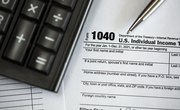
If you're a new freelance artist planning for tax season, you'll find that the tax filing process requires some extra work than if you worked for an employer. For example, at tax time you have to gather information about earnings for your freelance work – which used to come to you with a 1099-MISC but is now reported on the 1099-NEC for clients who pay you $600 or more – as well as the business expenses incurred, plus consider other tax-deductible expenses and credits that may be available to taxpayers in general.
You'll also find that you have to deal with some extra tax forms for reporting this info and paying self-employment tax. When you do this the first time, you might want to consult with a tax professional. Either way, take a look at how to file taxes as a freelancer doing art.
Read More: Form 1040: What's Changed for Your 2020 Tax Return
Tax Filing Basics for Freelancers
As a freelance artist, your business structure will affect how you do your taxes. However, in many cases, you'd be a sole proprietor or a single-member limited liability company where you fill out the same Internal Revenue Service Form 1040 federal tax return that a typical individual taxpayer would for their personal finances. The main difference is that business owners have extra forms to deal with regarding reporting business income and expenses, paying self-employment tax and handling special adjustments to income.
You need to be estimating your tax liability and paying quarterly taxes so that you can avoid penalties and a tax bill when you file your return. This means not only accounting for the federal income tax due on your artist income but also planning for the self-employment tax of 15.3 percent.
This means you pay the employee and employer contributions for Social Security and Medicare taxes since the IRS considers you self-employed. You should also check with your state to calculate any income tax due and make quarterly payments if necessary.
Determining Your Freelance Earnings
While you likely use some QuickBooks or some other system to keep track of earnings from your art throughout the tax year, you'll usually have some other documentation to look at to determine your gross income and tax rate to successfully file your taxes. For example, you should get IRS Form 1099-NEC, Nonemployee Compensation, from clients who paid you $600 or more that year. You'll find your earnings in box 1 on that tax form.
If you don't get this document, you can look at your bank statements and past invoices to determine how much each client paid you last year. You can then add all income sources together to get a gross earnings amount from which you'll be able to deduct things like businesses expenses.
Read More: What Is Form 1099-NEC?
Considering Your Business Expenses
As a freelance artist, you've likely incurred several business expenses that you can deduct from your gross earnings on your Schedule C, Profit or Loss From Business. You should have receipts, canceled checks, invoices or other documentation to back up all the related costs. Some things you can deduct as an artist include the following:
- Costs for advertising your artist services such as business cards and a portfolio website
- Your business license
- Relevant business, health, vision and dental insurance plans for yourself
- Professional services hired for your business such as legal help or bookkeeping
- Business travel (including vehicle use) and meals with clients
- Necessary supplies and equipment to create your artwork and run the business
- General office supplies
- Interest on business loans
- Subscriptions to art-related publications
- Continuing education such as classes on art software and techniques and seminars for artists
- Home office deduction, where you can use a simplified method of deducting $5 for every square foot used (up to 300 square feet or $1,500) or calculate the percentage and allocate home office expenses manually
Keep in mind you'll also be able to deduct half your self-employment tax. You'll also benefit from the 20 percent qualified business income deduction as long as you use a pass-through entity and have a taxable income of no more than $164,900 (if single) or $329,800 (if married filing jointly) in 2021.
Looking at Other Tax Deductions
Along with deducting independent contractor expenses, consider the numerous tax deductions for individuals as well. What's available will depend on whether you decide on the standard deduction or itemizing option, and you'll want to research relevant deductions since some have income limits or other requirements.
Some general deductions regardless of filing option include the student loan interest, retirement account and health savings account contribution deductions. On the other hand, itemizers have more options for tax deductions such as the following expenses:
- Charitable donations
- Medical expenses
- State and local taxes
- Mortgage interest, points and insurance
- Certain casualty and theft losses
Keep in mind the standard deduction may often work more in your favor since there's a good chance all your itemized expenses wouldn't be more than that. For example, consider the 2021 standard deduction is $12,550 for singles and $25,100 for married couples filing jointly. You also save yourself extra work by not itemizing. If you use a tax program such as TurboTax, it will prompt you for allowable write-offs and deductions under the current tax law.
Exploring Potential Tax Credits
As a freelance artist, you may still take advantage of general tax credits that particularly help since they directly reduce your taxes owed and may even provide a refund in some cases.
For example, you can take advantage of the Lifetime Learning Credit or American Opportunity Credit if you're in a qualified education program or the Earned Income Tax Credit if you're a lower earner. If you have a qualifying child or dependent, you might benefit from the Child Tax Credit, Adoption Credit or Child and Dependent Care Credit.
You'll also encounter other tax credit options such as the Saver's Credit for certain retirement plan contributors, Residential Energy Efficient Property Credit for certain home improvements and the Premium Tax Credit if you get insurance from the healthcare exchange and fall under a certain income.
Filing Your Federal Tax Return
When you're ready to file your federal tax return, have all your information and documentation ready to report your income and deductible expenses. You'll also want to know when you made your estimated tax payments and how much you paid. You can then decide to do your taxes yourself or hire a professional. While other forms may apply for certain credits and deductions, you'll likely encounter at least these common tax forms as a freelancer:
- Form 1040: This is the main U.S. Individual Income Tax Return where you'll fill in all your personal information, opt for the standard or itemized deduction, list dependents, report income sources along with certain credits and deductions and then determine the taxable income. You'll then get your amount of taxes owed or refunded.
- Schedule SE: You'll use this to figure your self-employment tax owed as well as account for the deduction of half the tax amount.
- Schedule 1: This tax form lists additional income and adjustments and is where your final business income goes along with several common deductions for individuals.
- Schedule 2: You use this form to report extra taxes due such as self-employment taxes and the alternative minimum tax.
- Schedule A: If you itemize, this form lists your various deduction options and has places to put the amounts and get the total.
- Schedule C: This is a very important form for a freelance artist since it's where you report your business's profit or loss by reporting your gross receipts, business expenses and other key items. You'll finish the form with the net profit or loss amount.
After your federal tax return is completed and you've made arrangements to pay any needed taxes or get your refund, you can file electronically for the quickest process or mail the return for a longer process of up to eight weeks. You'll also want to look into filing taxes in your state and possibly your city and consider the various deductions and credits available for individuals and businesses.
Read More: Form 1040: What You Need to Know
References
- IRS: 1099-NEC – Nonemployee Compensation
- IRS: Form 1040, Schedule C – Profit or Loss From Business
- IRS: Credits and Deductions for Individuals
- IRS: Simplified Option for Home Office Deduction
- NerdWallet: Tax Deductions Guide and 20 Popular Breaks in 2021
- IRS: Qualified Business Income Deduction
- IRS: IRS Provides Tax Inflation Adjustments for Tax Year 2021
- IRS: Form 1040, U.S. Individual Income Tax Return
- IRS: Schedule 1: Additional Income and Adjustments to Income
- IRS: Schedule 2, Additional Taxes
- IRS: Schedule SE – Self-Employment Tax
- IRS: Schedule A, Itemized Deductions
- IRS: How to File
- IRS: Self-Employed Individuals Tax Center
- IRS: Self-Employment Tax (Social Security and Medicare Taxes)
Writer Bio
Ashley Donohoe has written about business and technology topics since 2010. Having a Master of Business Administration degree, bookkeeping certification and experience running a small business and doing tax returns, she is knowledgeable about the tax issues individuals and businesses face. Other places featuring her business writing include Zacks, JobHero, LoveToKnow, Bizfluent, Chron and Study.com.

